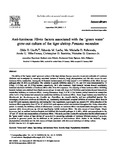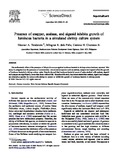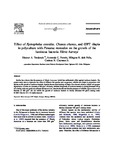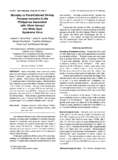Search
Now showing items 1-10 of 16
Induction of immunity and resistance to white spot syndrome virus (WSSV) in shrimp Penaeus monodon (Fabricius) by synthetic oligodeoxynucleotide and bacterial DNA
(University of the Philippines Los Baños, 2012)
Shrimps like all invertebrates are believed to lack true adaptive immunity but recent evidence indicate that they can be protected against pathogenic organisms by priming their immune system with immunostimulatory substances. ...
Evaluation of dietary freeze-dried Chaetoceros calcitrans supplementation to control Vibrio harveyi infection on Penaeus monodon juvenile
(Elsevier, 2014)
Effects of supplementation of diets with freeze-dried Chaetoceros calcitrans to control Vibrio harveyi infection are evaluated through immune responses, and disease resistance of juvenile Penaeus monodon. Total lipid and ...
Anti-luminous Vibrio factors associated with the ‘green water’ grow-out culture of the tiger shrimp Penaeus monodon
(Elsevier, 2005)
The ability of the “green water” grow-out culture of the tiger shrimp Penaeus monodon to prevent outbreaks of Luminous Vibriosis was investigated by screening associated isolates of bacteria, fungi, phytoplankton and fish ...
Studies on the chemical control of luminous bacteria Vibrio harveyi and V. splendidus isolated from diseased Penaeus monodon larvae and rearing water
(Inter Research, 1990)
The minimum inhibitory concentrations (MICs) and minimum bactericidal concentrations (MBCs) of 24 drugs for luminous bacteria Vibrio harveyi and V. splendidus were determined. Only chloramphenicol, sodium nifurstyrenate ...
Bacterial diseases in shrimp (Penaeus monodon) culture in the Philippines
(Japanese Society of Fish Pathology, 1998)
The hatchery system for Penaeus monodon evolved from the Japanese community culture system to the modified Galveston method and this shift in culture technique triggered the outbreak of diseases due to opportunistic bacteria. ...
Isolation of Vibrio spp. from Penaeus monodon (Fabricius) with red disease syndrome
(Elsevier, 1997)
From January 1990 to June 1993, 59% of the total juvenile to adult shrimp Penaeus monodon submitted for diagnosis at the Fish Health Section of the Aquaculture Department, Southeast Asian Fisheries Development Center, ...
Presence of snapper, seabass, and siganid inhibits growth of luminous bacteria in a simulated shrimp culture system
(Elsevier, 2006)
The antibacterial effect of the presence of Tilapia hornorum against luminous bacteria in shrimp culture has been reported. This study investigates how the presence of commercially valued marine species such as seabass, ...
Luminescent vibrios associated with mortality in pond-cultured shrimp penaeus monodon in the Philippines: Species composition
(Japanese Society of Fish Pathology, 2001)
Heavy mortalities due to luminescent vibriosis have been observed among pond-cultured Penaeus monodon shrimp in the Philippines. The species composition of luminescent Vibrio associated with mortalities was determined. A ...
Effect of Epinephelus coioides, Chanos chanos, and GIFT tilapia in polyculture with Penaeus monodon on the growth of the luminous bacteria Vibrio harveyi
(Elsevier, 2006)
Studies have shown that the presence of Tilapia hornorum hybrid has antibacterial effect against luminous bacteria. The present study aims to determine the effect of different fish species such as grouper, milkfish and ...
Mortality in pond-cultured shrimp Penaeus monodon in the Philippines associated with Vibrio harveyi and white spot syndrome virus
(Japanese Society of Fish Pathology, 2003)
Heavy mortalities were observed among pond-cultured Penaeus monodon in the provinces of Bohol, Misamis Occidental, Lanao del Norte and Zamboanga del Sur, Philippines. Vibrio harveyi was isolated purely from the hepatopancreas ...











